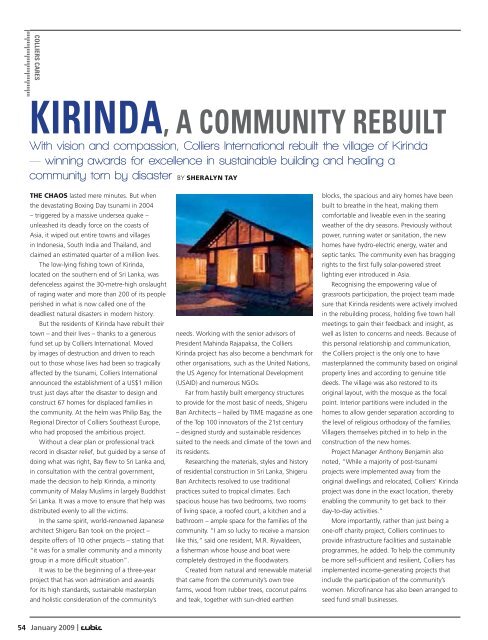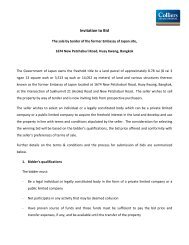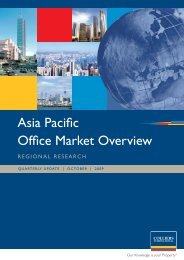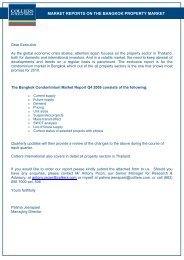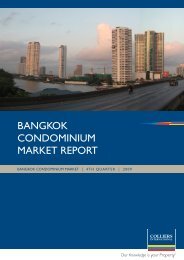CUBIC CoverDec08.indd - Colliers
CUBIC CoverDec08.indd - Colliers
CUBIC CoverDec08.indd - Colliers
You also want an ePaper? Increase the reach of your titles
YUMPU automatically turns print PDFs into web optimized ePapers that Google loves.
COLLIERS CARES<br />
KIRINDA, A COMMUNITY REBUILT<br />
With vision and compassion, <strong>Colliers</strong> International rebuilt the village of Kirinda<br />
— winning awards for excellence in sustainable building and healing a<br />
community torn by disaster BY SHERALYN TAY<br />
THE CHAOS lasted mere minutes. But when<br />
the devastating Boxing Day tsunami in 2004<br />
– triggered by a massive undersea quake –<br />
unleashed its deadly force on the coasts of<br />
Asia, it wiped out entire towns and villages<br />
in Indonesia, South India and Thailand, and<br />
claimed an estimated quarter of a million lives.<br />
The low-lying fishing town of Kirinda,<br />
located on the southern end of Sri Lanka, was<br />
defenceless against the 30-metre-high onslaught<br />
of raging water and more than 200 of its people<br />
perished in what is now called one of the<br />
deadliest natural disasters in modern history.<br />
But the residents of Kirinda have rebuilt their<br />
town – and their lives – thanks to a generous<br />
fund set up by <strong>Colliers</strong> International. Moved<br />
by images of destruction and driven to reach<br />
out to those whose lives had been so tragically<br />
affected by the tsunami, <strong>Colliers</strong> International<br />
announced the establishment of a US$1 million<br />
trust just days after the disaster to design and<br />
construct 67 homes for displaced families in<br />
the community. At the helm was Philip Bay, the<br />
Regional Director of <strong>Colliers</strong> Southeast Europe,<br />
who had proposed the ambitious project.<br />
Without a clear plan or professional track<br />
record in disaster relief, but guided by a sense of<br />
doing what was right, Bay flew to Sri Lanka and,<br />
in consultation with the central government,<br />
made the decision to help Kirinda, a minority<br />
community of Malay Muslims in largely Buddhist<br />
Sri Lanka. It was a move to ensure that help was<br />
distributed evenly to all the victims.<br />
In the same spirit, world-renowned Japanese<br />
architect Shigeru Ban took on the project –<br />
despite offers of 10 other projects – stating that<br />
“it was for a smaller community and a minority<br />
group in a more difficult situation”.<br />
It was to be the beginning of a three-year<br />
project that has won admiration and awards<br />
for its high standards, sustainable masterplan<br />
and holistic consideration of the community’s<br />
needs. Working with the senior advisors of<br />
President Mahinda Rajapaksa, the <strong>Colliers</strong><br />
Kirinda project has also become a benchmark for<br />
other organisations, such as the United Nations,<br />
the US Agency for International Development<br />
(USAID) and numerous NGOs.<br />
Far from hastily built emergency structures<br />
to provide for the most basic of needs, Shigeru<br />
Ban Architects – hailed by TIME magazine as one<br />
of the Top 100 innovators of the 21st century<br />
– designed sturdy and sustainable residences<br />
suited to the needs and climate of the town and<br />
its residents.<br />
Researching the materials, styles and history<br />
of residential construction in Sri Lanka, Shigeru<br />
Ban Architects resolved to use traditional<br />
practices suited to tropical climates. Each<br />
spacious house has two bedrooms, two rooms<br />
of living space, a roofed court, a kitchen and a<br />
bathroom – ample space for the families of the<br />
community. “I am so lucky to receive a mansion<br />
like this,” said one resident, M.R. Riyvaldeen,<br />
a fisherman whose house and boat were<br />
completely destroyed in the floodwaters.<br />
Created from natural and renewable material<br />
that came from the community’s own tree<br />
farms, wood from rubber trees, coconut palms<br />
and teak, together with sun-dried earthen<br />
blocks, the spacious and airy homes have been<br />
built to breathe in the heat, making them<br />
comfortable and liveable even in the searing<br />
weather of the dry seasons. Previously without<br />
power, running water or sanitation, the new<br />
homes have hydro-electric energy, water and<br />
septic tanks. The community even has bragging<br />
rights to the first fully solar-powered street<br />
lighting ever introduced in Asia.<br />
Recognising the empowering value of<br />
grassroots participation, the project team made<br />
sure that Kirinda residents were actively involved<br />
in the rebuilding process, holding five town hall<br />
meetings to gain their feedback and insight, as<br />
well as listen to concerns and needs. Because of<br />
this personal relationship and communication,<br />
the <strong>Colliers</strong> project is the only one to have<br />
masterplanned the community based on original<br />
property lines and according to genuine title<br />
deeds. The village was also restored to its<br />
original layout, with the mosque as the focal<br />
point. Interior partitions were included in the<br />
homes to allow gender separation according to<br />
the level of religious orthodoxy of the families.<br />
Villagers themselves pitched in to help in the<br />
construction of the new homes.<br />
Project Manager Anthony Benjamin also<br />
noted, “While a majority of post-tsunami<br />
projects were implemented away from the<br />
original dwellings and relocated, <strong>Colliers</strong>’ Kirinda<br />
project was done in the exact location, thereby<br />
enabling the community to get back to their<br />
day-to-day activities.”<br />
More importantly, rather than just being a<br />
one-off charity project, <strong>Colliers</strong> continues to<br />
provide infrastructure facilities and sustainable<br />
programmes, he added. To help the community<br />
be more self-sufficient and resilient, <strong>Colliers</strong> has<br />
implemented income-generating projects that<br />
include the participation of the community’s<br />
women. Microfinance has also been arranged to<br />
seed fund small businesses.<br />
54<br />
January 2009 |


